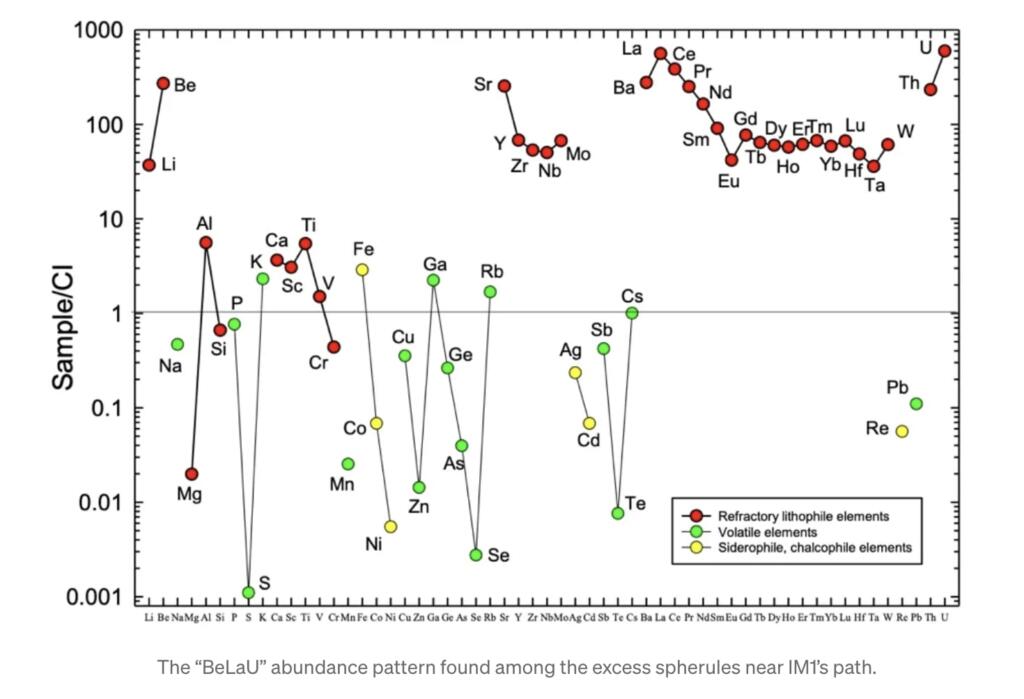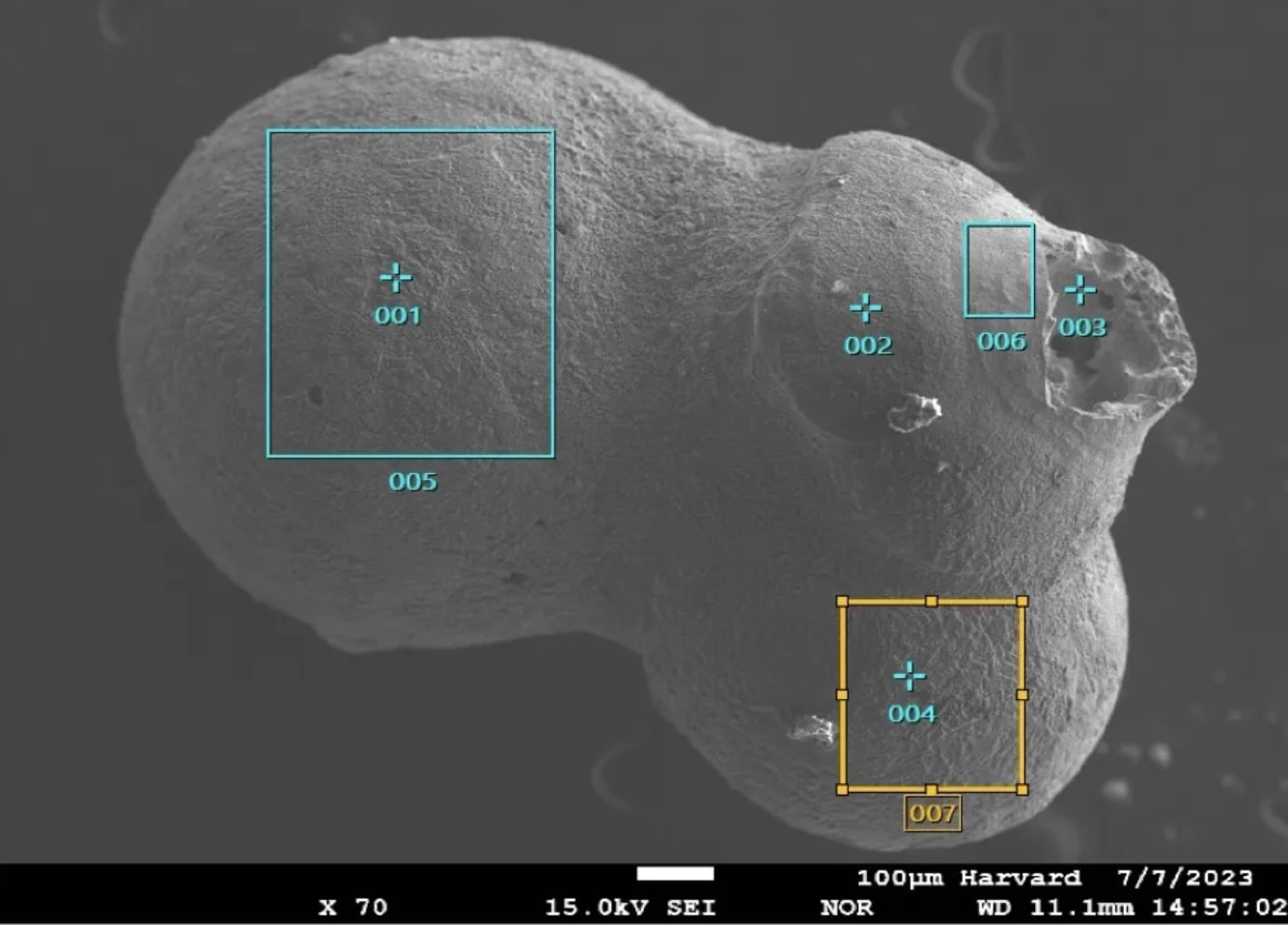Small melted prices of the IM1 interstellar meteor have been found and measured. The tiny pieces have levels beryllium (Be), lanthanum (La) and uranium (U), dubbed “BeLaU” that are hundreds of times above solar-system rocks. Can we determine whether IM1 was natural or technological in origin? The team led by Avi Loeb of Harvard who found the remains of the crashed meteor will try.
IM1 was detected over the South Pacific, off the northern coast of Papua New Guinea, in 2014. It is also called CNEOS 20140108. The meteor had an estimated mass of 460 kg and was between 80 cm and 1 m (2.6-3.3 feet) in diameter. A few milligrams of material that have been found. Many larger multi-kilogram pieces could still be found.
UPDATE: Nextbigfuture has a new articles that explain that spaceships are not immortal. They stop working but unlike regular ships they do not sink into the ocean. Spaceships just keep coasting until they crash.

If natural, IM1 could be the product of a planet with a magma ocean and an iron core, where elements with affinity to iron sink towards the core and other elements left behind in the planet’s crust reflect the “BeLaU” abundance pattern discovered in their new scientific paper.
In an unprecedented gesture, the arXiv administrators chose to highlight the paper with a dedicated video featuring a summary of the paper’s findings, read by artificial intelligence (AI).
If IM1 was technological in origin, then the enhanced abundance of heavy elements in “BeLaU”-type spherules could have resulted from the fact that LaO over Mo or W sulfide substrates are promising materials for 2D semiconductors in nanotech fabrication. Uranium is used in fission reactors.
Radioactive isotopes in the “BeLaU”-type spherules can be used as clocks, based on their known half-life and the relative abundance of daughter and parent nuclei.

The abundance of beryllium would accumulate from interstellar cosmic-ray collisions.
Measuring the duration of IM1’s journey and multiplying it by its known velocity outside the solar system, could inform us of the distance and direction of its source star.
They will try to use AI code to simulate the properties of alloys based upon the mixture of elements they have found.
They have mapped where the excess IM1 spherules were located relative to the background material in the control regions that they surveyed. They can forecast where large pieces could have landed based on their size. Smaller objects slow down faster because of their larger area-to-volume ratio.

Brian Wang is a Futurist Thought Leader and a popular Science blogger with 1 million readers per month. His blog Nextbigfuture.com is ranked #1 Science News Blog. It covers many disruptive technology and trends including Space, Robotics, Artificial Intelligence, Medicine, Anti-aging Biotechnology, and Nanotechnology.
Known for identifying cutting edge technologies, he is currently a Co-Founder of a startup and fundraiser for high potential early-stage companies. He is the Head of Research for Allocations for deep technology investments and an Angel Investor at Space Angels.
A frequent speaker at corporations, he has been a TEDx speaker, a Singularity University speaker and guest at numerous interviews for radio and podcasts. He is open to public speaking and advising engagements.


Why is it always an alien technology that is the first possibility? Absolutely ridiculous.
There was the OR it was from a different kind of exoplanet crust or a solar system with unusual processes.
This meteor is not a product of an alien civilization. Neither are others. Neither is Oumuamua.
Sorry, aliens do not show up everywhere just because a guy from Harvard decided to change his professions from science to show business. Please stop feeding his followers.
Silliness.
We need to see evidence of complexity (not rareness or difference) – that is specialized alloys/ compounds, mechatronic fragments, patternicity, advanced organics designed for durability, etc., etc. Though, it is certainly worthwhile to approach, map, survey, and sample such interstellar wayfarers – even hitch a ride.
Perhaps, it would be more useful to further assess the types of elements given off by more specialized stellar and other (bHoles, novas, etc.,) sources and assess this item’s exposure to same.
Beryllium or Beryl, was used in the 19th and 20th centuries to harden the steel in gun barrels. There are dozens of abandoned beryl mines throughout the southeast US. One of my favorite places to go rock hunting is “Rays Mica Mine” near Burnsville NC. They mined mica and beryl there, but now it’s part of the Pigush National Forest.
https://www.mindat.org/loc-5494.html
The uranium, well I guess that would depend on the isotope. No idea on the Lanthanum.
I can’t help but wonder what they’d find if they were looking with something other than a magnet sled; They can only pick up ferromagnetic materials the way they’re doing it.